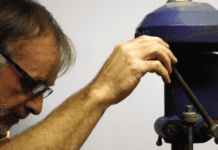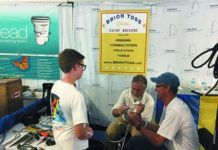In these parts of New England, we envy the people of the Chesapeake, for while we have The Box, they have The Woman. Here, NOAA’s National Weather Service broadcasts drone on in that now-old artificial voice so bereft of expression that, while the words can be understood, their significance can’t be grasped without intense concentration. It’s like listening to a toaster. But down in the Bay, the voice of The Woman tells the weather. When she speaks of heating-degree days… now that’s a forecast.
The Woman I recently heard in the Chesapeake might have been the remains of an experiment in which NWS had an actual person with a pleasant speaking voice record the hundreds of individual words that make up the typical weather report, then linked those words to the keyboard, thus producing a digital broadcast recording. But, no-I’m pretty sure The Woman was Donna, who (which?) is the result of a $633,615 contract between the NWS, Siemens of Boca Raton, and Speechworks of Boston, to create a better artificial voice for us.
Donna’s voice is a big improvement. True, she doesn’t croon her report with any heartfelt connection to her listeners, and this is a Stepford-like let-down. Even so, she’s absolutely vibrant compared to The Box. We expect to welcome her (and her electro-male counterpart, Craig) to New England soon.
In the July 15th issue we have a short evaluation of handheld weather stations. These are clever gadgets that take up little space and don’t cost much. The only thing they require in order to be of benefit is some interest in the weather on your part.
Personal weather understanding, like dead-reckoning, is a skill that’s being lost to the high-tech fix. Today, most weather forecasts, including the NWS, local and national TV and radio, and Internet sources, are all linked to the same or similar behemoth data and satellite networks, and the information that comes to us is astoundingly good. It would be imprudent to ignore it, just as it would be silly not to carry a GPS receiver when venturing afar these days. The difference is that a GPS receiver reports concrete facts; the weather networks, with all their skills and satellites, report the movement of air and vapor over uneven land and shifting fluid. It’s not the same kind of accuracy at all. Meanwhile, there you are, some miles offshore, with a just-developed bank of gray coming at you, a rapid change in air temperature and humidity, and nuttin’ about it on the radio.
You and your crew are the ones actually living in the weather you care about, and in the path of weather to come. There’s a reason why so many generations of sailors have carefully recorded wind direction, windspeed, and barometer readings in the logbook, every hour of every passage. With that record and a bit of understanding, you can get a clue about what’s coming at you.
There are details of meteorology that, for most of us, are not worth learning, but knowing the basics of the weather is just as important-in terms of being able to take care of ourselves-as a general understanding of other complexities on which we may rely, like the diesel engine, the notebook computer, or the arithmetic and vector geometry behind position-finding. Even if all mechanical helpers work fine, it’s worth knowing the same things they know, if by slower, “human” methods. It’s partly about safety, and partly about fun and self-sufficiency.
Meteorology, at its practical level, isn’t hard to absorb. It only requires a bit of attention (and, for me, frequent reviews and a lot of notes). Still, armed with a barometer and thermometer, a copy of “Fitzroy’s Barometer Instructions” (circa 1863; Fitzroy captained Darwin’s Beagle), and your own eyes, you can wrest a bit of sense out of the swirl. Not so much that you’d put Donna out of a job, though.
-Doug Logan



































